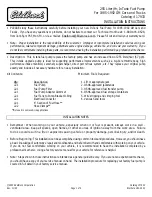
drive smart center. If incorrectly sized
rims and tires are mounted, the wheel
brakes or suspension components can be
damaged. Also, the operating clearance of
the wheels and the tires may no longer be
correct.
Worn, old tires can cause accidents. If the
tire tread is worn to minimum tread depth,
or if the tires have sustained damage,
replace them.
When replacing rims, only use genuine
smart wheel bolts specified for the
particular rim type. Failure to do so can
result in the bolts loosening and possibly
an accident.
Retreaded tires are not tested or
recommended by smart, since previous
damage cannot always be recognized on
retreads. The operating safety of the
vehicle cannot be assured when such tires
are used.
If you feel a sudden significant vibration
or ride disturbance, or you suspect that
possible damage to your vehicle has
occurred, you should turn on the hazard
warning flashers, carefully slow down, and
drive with caution to an area which is a safe
distance from the road.
Inspect the tires and the vehicle underbody
for possible damage. If the vehicle or tires
appear unsafe, have the vehicle towed to the
nearest authorized electric drive smart
center or tire dealer for repairs.
Do not drive with a flat tire. A flat tire
affects the ability to steer or brake the
vehicle. You could lose control of the
vehicle. Continued driving with a flat tire
or driving at high speed with a flat tire
will cause excessive heat build-up and
possibly a fire.
Modifications to the brake system and
wheels and the use of brake dust rings are
not permissible.
R
Only use sets of tires and rims of the same
type and make.
R
Tires must be of the correct size for the
rim.
R
Break in new tires for approximately
60 miles (100 km) at moderate speeds.
R
Regularly check the tires and rims for
damage. Dented or bent rims can cause
tire pressure loss and damage to the tire
beads.
R
If vehicle is heavily loaded, check tire
inflation pressure and correct as
required.
R
Do not allow your tires to wear down too
far. Adhesion properties on wet roads are
sharply reduced at tread depths of less
than
1
/
8
in (3 mm).
Recommended tire inflation pressure
Follow recommended tire inflation
pressures.
Do not underinflate tires. Underinflated
tires wear excessively and/or unevenly,
adversely affect handling and energy
consumption of the vehicle, and are more
likely to fail from being overheated.
Do not overinflate tires. Overinflated
tires can adversely affect handling and
ride comfort, wear unevenly, increase
stopping distance, and result in sudden
deflation (blowout) because they are more
likely to become punctured or damaged by
road debris, potholes etc.
Do not overload the tires by exceeding the
specified load limit as indicated on the
Tire and Loading Information placard on
the driver’s door B‑pillar. Overloading the
Tires and wheels
105
>> Operation.
Z
Содержание fortwo cabriolet
Страница 1: ...Operator s Manual smart fortwo coup and smart fortwo cabriolet...
Страница 4: ......
Страница 29: ...Safety Occupant safety 28 Panic alarm 43 Driving safety systems 44 Anti theft systems 47...
Страница 50: ...48...
Страница 96: ...94...
Страница 138: ...136...
Страница 180: ...Fuse box Front side Fuse y Backup fuse slots 178 Fuses Practical hints...
Страница 184: ...182...
Страница 196: ...4515849982l 4515849982 Order no 6522 0050 13 Part no 451 584 99 82 Edition A 2012 www smart com smart A Daimler brand...
















































